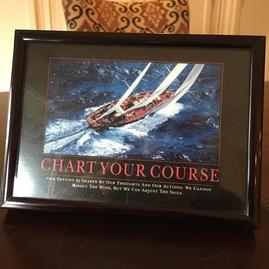Leading: Adjust the Sails
I’ve kept this picture on the corner of my desk for quite a few years. It serves as a daily reminder to me, and to those who come meet with me, that it’s necessary for us to continually make adjustments to reach desired goals. The art of sailing teaches that concept in a most tactile way! I suppose that’s one of the reasons I enjoy it so much.
As a leader, you’re the captain of your ship. It’s wise to know where you want it to go and to adapt accordingly.
Business is a dynamic entity, especially with the rate of change we are experiencing through technological disruption, economic cycles and governmental action (or inaction). Presuming you have done the important work necessary to move your business forward and you’re finally enjoying the momentum that growth brings with it, you can’t simply set it and forget it. There isn’t an autopilot for business any more than there is one for a sailboat under wind power. Leaders must chart their course, fix their eyes on the horizon and note the compass heading, all while keeping a steady hand on the tiller and adjusting the sheets as needed to compensate for the direction of the wind. It’s interactive and multifaceted. Sailing isn’t a power cruise and neither is leading a business.
For those of us in the green industry, we are closer to living the sailing experience than many other industries. We’ve got all of the variables of any business, plus that wild card called weather. Occasionally, those events are even named such things as Harvey and Irma. When those events blow through, you’ve got to hold tight.
What are three big things a leader can adjust to keep the business on course? I’ll touch on them:
- Strategic direction. There was a time when strategic plans or business plans looked out multiple years and were revisited infrequently (if at all). We don’t live in those times! Today, a strategy document should be living and iterative; it requires a regular review to keep it fresh and relevant. Know your destination and make your plans for getting there; without them, any course will do and you just might run aground.
- Critical resources. Know the human, material and equipment resources required to execute your plan. Don’t wait until you’re in trouble to adjust those inputs to match the economic conditions you’re facing. Track the people part daily and weekly. It’s your biggest controllable resource.
- Communication. Keep the crew plugged in to the plans and any adjustments that are made to them. Let them know “why” and not just “what,” since they can often see needed changes before the leader does. Many companies worry more about how to protect (or hide) information than how to share it; it’s only when your team knows the plan that they can contribute to improving it.







One Comment
Leave a Reply
Greg Hodges
7 years agoWonderful analogy. I have spent many years sailing, and one thing is for sure. You cannot control your environment, but you certainly can plan for the challenges that WILL arise. I hope you are well Bill.